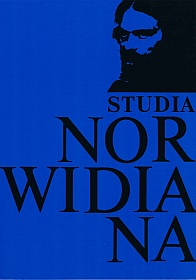The Style of Norwid’s Poetry and the Poetic Tradition
Abstract
The author confronts Norwid’s poems (those appearing in the first two wolumes of Gomulicki’s edition) with the stylistic and linguistic tradition of Romanticism as represented by Romantic poems that antedated Norwid’s work. She distinguishes four types of links between the poems of Norwid and those of other authors:
(1) Echoes, whose function in Norwid’s poetry is a general structural one; only a few selected, stylistically marked features are taken over from the reference text.
(2) Pastiches, which serve a variety of purposes, such as establishing contact with the poem’s addressee.
(3) Oppositions in the stylistic or ideological sense; this category is the most characteristic of Norwid.
(4) Parallelisms, i.e. parallel stylistic tendencies manifested by the texts compared; they represent loose connections rather than direct references.
References to the texts of other poets mostly appear in Norwid in his first lines, versification structures and key words. In many poems we can see convention vying with innovation. Type 1. This is illustrated by such poems as Italiam! Italiam!, which represents the genre of barcarole and invokes first of all a passage from Krasinski’s Przedświt; Słuchacz, with its first line an imitation of the Goethe/Mickiewicz Znasz-li ten kraj (Kennst du das Land); and Trzy strofki, which mirrors the rhetorical structure of Krasinski’s Zawsze i wszędzie. Type 2. The foremost example is Norwid’s Na przyjazd Teofila Lenartowicza do Fontainebleau, which imitates the style of Lenartowicz’s Lirenka.
Type 3. Oppositions may have many different realizations. For instance, in Do Józefa Bohdana Zaleskiego Norwid makes use of the range of vocabulary characteristic of Zaleski’s poetry but introduces an atypical repulsive comparison. The tragic poem Czemu stands in opposition to Mickiewicz’s playful sonnet Do D. D. Wizyta, and Moja piosnka [II] to Slowacki’s Hymn. The description of Aniela in Beniowski is matched by Norwid’s poem which begins with the words „Jak gdy kto ciśnie w oczy człowiekowi / Garścią fiołkow”, where Norwid draws on the traditional elements of description of feminine beauty while transforming them in a creative way; one example is the comparison of a woman to a goddess.
Type 4. Parallelisms are represented for instance by Norwid’s archaizing poems such as Bema pamięci żałobny-rapsod; the poem Na portret generała Dembińskiego is a case of heroic stylization parallel to many Romantic poems.
The author of the study also examines various parallel stylistic tendencies as revealed by the poetic figures in Norwid and in Romantic texts. The conclusion of the analysis is that Norwid’s poetic style was more innovative than the style of his predecessors.
Copyright (c) 1990 Studia Norwidiana

This work is licensed under a Creative Commons Attribution-NonCommercial-NoDerivatives 4.0 International License.





